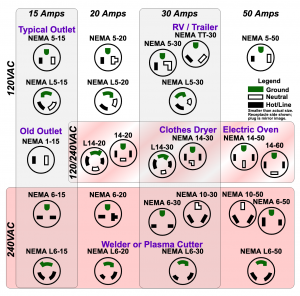In the first part of this series, we discussed the critical need for an uninterruptible power supply (UPS) to ensure business continuity and ongoing technical service. UPSes are used in offices, data centers, and other areas where sensitive or critical equipment is located; they prevent a sudden and unexpected loss of power from damaging equipment – or data stored on the equipment.
When purchasing a UPS for your business, it’s important to look at the available incoming power supply. The first thing to consider would be the things to which you are planning to provide power from the UPS, and what kind of power they take. From there, review what kind of power is available to you from your building power supply or utility.
How does voltage play a role in UPS investment?
First, a note about voltage: While we usually think of voltage in terms of 110 volts (or 110v), 115v, 120v, 125v, etc., the fact is that voltage is never constant; voltage is a potential. It is the difference in electrical potential between the power source and the device consuming the power. Because we typically deal with AC (Alternating Current), this will necessarily vary throughout the alternating phase (alternating between a negative and a positive charge).
This can get pretty deep in the weeds; what’s important to note is that voltage is not steady (even with DC current). Normal household current (and office current) in North America is delivered at 120v. As a result of wiring resistance, the voltage may be 115v or even 110v before it reaches your equipment. This is OK, as most equipment will handle between 110v to 125v. To keep it simple, we’re going to refer to this range of voltage as 120v.
To get higher voltages, two or more circuits can be combined. Usually, in most office environments, two 120v lines can be combined to get a 240v circuit. Most computer equipment can handle up to 240v and providing higher voltage circuits can actually provide more efficient power usage by equipment.
In larger environments, such as data centers, manufacturing plants, etc., there might be 3-phase power, which can deliver up to 480v (in North America).
Since we are mostly discussing computers and networking equipment, we will note that 3-phase power usually ends up providing 208v in these environments. When you are looking at a scenario where you are willing to assume the cost of multi-phase circuits, you will be in a data center environment, which usually provides the 208v; but the discussion below also applies to UPSes which also work with 240v to 250v environments.
What are the amperage requirements?
While voltage concerns the amount of potential power available on a circuit, amperage refers to the amount of power flowing through a conductor (an electrical circuit) at a given time. It is governed by such things as the circuit breaker capacity for the circuit, the size of the wires involved in the circuit, and the types of outlets connected to the circuit.
The unit of measure for amperage is the ampere, commonly referred to as Amps. Most home and office environments have circuits rated at 15 or 20 Amps (15A, 20A). More industrial environments may have larger capacity circuits; commonly 30A or 50A circuits. The Amp rating of a circuit, along with the voltage, will ultimately determine the amount of work done by the circuit, which will determine how much equipment, and of what “size,” you can put on a single circuit.
Why is this important? You will want to make sure you are not overloading any given circuit with the equipment to which you are planning to connect. This can involve a lot of consulting work and planning, which might require additional insight from a trusted partner. If you are looking to put existing equipment on a UPS, you probably are not overloading the circuits providing the utility power – unless you are getting a UPS because you keep tripping the circuit breakers.
How do incoming power outlets affect UPS selection?
The voltage and amperage of your incoming utility power will determine the type of outlet to which you want to connect. 120v circuits have a certain set of outlet configurations which vary depending on amperage. You should consider whether you want a locking connector, which is used to prevent inadvertent disconnect of the UPS from the main utility power.
There are two main types of outlets governed by different regulatory standards:

Image from Orion Lawlor, CC BY-SA 3.0, via Wikimedia Commons
- International Electrotechnical Commission (IEC) 60320 Standard – more typically found in computer environments like data centers or on some UPS equipment and Power Distribution Units (PDUs). To see a full chart, click here.
UPS output power outlets
Most UPSes will have an array of output outlets to which equipment (or PDUs) can be connected. While each outlet will frequently provide a separate circuit, the total load on the UPS is restricted to the load provided by the UPS (usually rated in Watts). So, if you have a number of 15A outlets (i.e., 5-15R), each capable of up to 12A*, you can’t pull more power out of the UPS than it is rated for, as that would overload the incoming power circuit.
Larger UPSes will have a mix of circuits, usually with some 15A, and 1 or 2 20A or 30A circuits. Some of the 20A and 30A circuits have locking outlets (e.g., NEMA L5-20 for a 120v 20A circuit), which are designed for use by PDUs (where you don’t really want the PDU power cord to be inadvertently disconnected from the UPS). This is a design consideration that needs to be considered.
What are the next steps for UPS selection?
As a business begins to identify the need for a UPS, the supply requirements may change based on the equipment being plugged in and the voltage requirements for the technology in use. An important part of the design of your organization’s UPS implementation is in identifying these requirements and selecting technology that can deliver the kind of results you need. Consulting a professional can go a long way in providing that guidance, as well, and ZAG specializes in the knowledge necessary to make these selections. Contact us to learn more.
* Most circuit breakers are set to trip at 80% of the rated load of any given circuit. Thus, 15A circuits are limited to 12A, 20A circuits are limited to 16A, 30A circuits are limited to 24A, etc.



